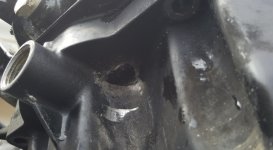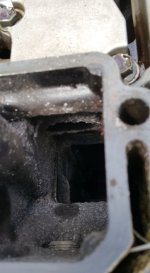It really pains me to say this but you can count the crew of C-Dancer as another victim of the dreaded “Suzuki Corrosion” issues suffered by owners of DF90-DF115-DF140 motors of the vintage years 2002-2007. We have a 2006 DF90 that I’ve been championing for years as being a great motor with virtually no mechanical issues or problems. NO MORE AND NOT HAPPY! EXTREMELY DISGUSTED!! :evil:
For those not familiar with this issue, a steel plug installed on the “engine holder”, basically an exhaust pan installed just under the power head and on top of the oil pan, caused corrosion to the aluminum engine holder (and for some the aluminum oil pan) due to dissimilar metals. This corrosion is not caused by failure to flush the engine, which I have always done but is caused by exhaust. If you look on this site and others on the net, this issue has caused failures in a large number of motors of this vintage. And of course Suzuki will not stand by their product and implement a recall or any recourse because “Corrosion” is not covered by warranty, even if it was their poor engine design which caused it. Of course, they did away with the steel plug altogether in the newer engines manufactured after 2008, sealing the hole in the casting, hmmm wonder why? Apparently replacement of these defective parts effectively solves the problem but only after a huge repair bill. Google “Suzuki Corrosion” and you’ll see many similar sad tales on the net as well as well-documented threads on C-Brats, i.e. TimFlan, RogerAR, Gene&Mary etc. Thoughts of initiating a class-action suit have been swirling in my brain.
We started having idle problems when we were at Winter Harbour in July. The motor would die at idle and would not start immediately at the turn of the key as it always had. I didn’t really have time to diagnose the problem before going on our next big trip to Canada last month to Powell River. The problem got worse, dying out frequently at idle and not being able to start without throttle. I was hoping it would be an easy fix like replacement of the IAC valve which I had read about in a few websites. What’s curious is that we ran the motor very hard this past summer and of course it got us through the stressful following sea adventure in the Strait of Georgia. I was told by the mechanic that the stalling symptoms do not occur at high speeds because the exhaust is forced out at higher RPM’s. It only occurs at idle or low RPM’s when the exhaust from the leak is trapped in the cowling.
Finally after the Bellingham gathering, we brought the boat to Master Marine in Mount Vernon. They finally got a chance to look at it and lo and behold, found a hole in the oil pan, not the engine holder that many owners have experienced. Back in the spring of 2014, I successfully removed the steel plug that was the source of all these corrosion problems and replaced with an aluminum plug bought off EBay. Maybe that had something to do with the engine holder not corroding through. However, the corrosion must have already made its way down to the oil pan below because the hole is pretty big, probably quarter sized. I was hoping we dodged the bullet by successfully changing out the steel plug with the aluminum plug. Plus the boat has been meticulously cared for and serviced every year. But obviously I wasn’t successful in stemming the tide of corrosion.


So I’m being told that both the engine holder and the oil plan need to be replaced plus all the associated parts, gaskets, bolts etc. Apparently the power head was a bear to get off and took several hours. The final bill for replacing all those parts plus at least 10-20 estimated labor hours would cost more than half of what a new engine would cost. So you guessed it, I have little choice but to purchase a new engine rather than putting big $$$$ towards a 10 year old motor. Interestingly, I just reached exactly 1000 hours on the motor. So I suppose an optimist would say I got 10 years and 1000 hours on an outboard motor with maximized, hard-working usage for 11 seasons and now I get to repower with a much lighter motor, newer technology and rave reviews on the net. The pessimist in me says, “We’ll see” in terms of any problems or issues popping up with this new era of Suzuki motors. With the support of the Admiral, we chose to repower with a Suzuki DF90A, which is 75 lbs. lighter than the 2006 DF90. I looked at other motors, specifically Yamaha’s, but they are a little heavier and would require us to install new gauges and control box, another $1000. So with great reluctance and trepidation, we are biting the bullet and getting a new Suzuki. Time will tell if this was the right choice.
So a word of warning to Suzuki owners of motors of this vintage, as Pat Anderson has stated repeatedly about Wallas Stoves, “it’s not a matter of if but when” your motor will fail due to corrosion. I’m so sorry to have to admit that. So is my pocket book.
For those not familiar with this issue, a steel plug installed on the “engine holder”, basically an exhaust pan installed just under the power head and on top of the oil pan, caused corrosion to the aluminum engine holder (and for some the aluminum oil pan) due to dissimilar metals. This corrosion is not caused by failure to flush the engine, which I have always done but is caused by exhaust. If you look on this site and others on the net, this issue has caused failures in a large number of motors of this vintage. And of course Suzuki will not stand by their product and implement a recall or any recourse because “Corrosion” is not covered by warranty, even if it was their poor engine design which caused it. Of course, they did away with the steel plug altogether in the newer engines manufactured after 2008, sealing the hole in the casting, hmmm wonder why? Apparently replacement of these defective parts effectively solves the problem but only after a huge repair bill. Google “Suzuki Corrosion” and you’ll see many similar sad tales on the net as well as well-documented threads on C-Brats, i.e. TimFlan, RogerAR, Gene&Mary etc. Thoughts of initiating a class-action suit have been swirling in my brain.
We started having idle problems when we were at Winter Harbour in July. The motor would die at idle and would not start immediately at the turn of the key as it always had. I didn’t really have time to diagnose the problem before going on our next big trip to Canada last month to Powell River. The problem got worse, dying out frequently at idle and not being able to start without throttle. I was hoping it would be an easy fix like replacement of the IAC valve which I had read about in a few websites. What’s curious is that we ran the motor very hard this past summer and of course it got us through the stressful following sea adventure in the Strait of Georgia. I was told by the mechanic that the stalling symptoms do not occur at high speeds because the exhaust is forced out at higher RPM’s. It only occurs at idle or low RPM’s when the exhaust from the leak is trapped in the cowling.
Finally after the Bellingham gathering, we brought the boat to Master Marine in Mount Vernon. They finally got a chance to look at it and lo and behold, found a hole in the oil pan, not the engine holder that many owners have experienced. Back in the spring of 2014, I successfully removed the steel plug that was the source of all these corrosion problems and replaced with an aluminum plug bought off EBay. Maybe that had something to do with the engine holder not corroding through. However, the corrosion must have already made its way down to the oil pan below because the hole is pretty big, probably quarter sized. I was hoping we dodged the bullet by successfully changing out the steel plug with the aluminum plug. Plus the boat has been meticulously cared for and serviced every year. But obviously I wasn’t successful in stemming the tide of corrosion.


So I’m being told that both the engine holder and the oil plan need to be replaced plus all the associated parts, gaskets, bolts etc. Apparently the power head was a bear to get off and took several hours. The final bill for replacing all those parts plus at least 10-20 estimated labor hours would cost more than half of what a new engine would cost. So you guessed it, I have little choice but to purchase a new engine rather than putting big $$$$ towards a 10 year old motor. Interestingly, I just reached exactly 1000 hours on the motor. So I suppose an optimist would say I got 10 years and 1000 hours on an outboard motor with maximized, hard-working usage for 11 seasons and now I get to repower with a much lighter motor, newer technology and rave reviews on the net. The pessimist in me says, “We’ll see” in terms of any problems or issues popping up with this new era of Suzuki motors. With the support of the Admiral, we chose to repower with a Suzuki DF90A, which is 75 lbs. lighter than the 2006 DF90. I looked at other motors, specifically Yamaha’s, but they are a little heavier and would require us to install new gauges and control box, another $1000. So with great reluctance and trepidation, we are biting the bullet and getting a new Suzuki. Time will tell if this was the right choice.
So a word of warning to Suzuki owners of motors of this vintage, as Pat Anderson has stated repeatedly about Wallas Stoves, “it’s not a matter of if but when” your motor will fail due to corrosion. I’m so sorry to have to admit that. So is my pocket book.
